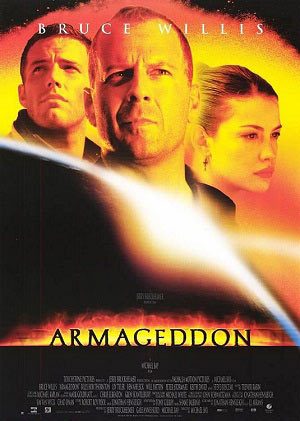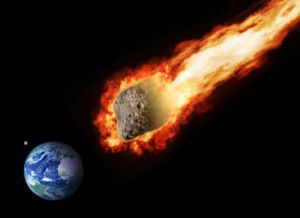Create a free profile to get unlimited access to exclusive videos, sweepstakes, and more!
"Armageddon" had bad science. Shocker, I know.

 I do so love to make fun of the movie "Armageddon". I know, it's such an easy target, but still.
I do so love to make fun of the movie "Armageddon". I know, it's such an easy target, but still.
I talk about the movie when I give public lectures about asteroid impacts, because a lot of people have seen it - so it's a nice common point of contact - and because it really goes out of its way to get so much stuff wrong.
The premise of the movie is that a giant asteroid is going to hit the Earth and wipe out all life. I'll skip a vast amount of silliness and get to the thing that really made me laugh out loud when I first saw the flick: to prevent the impact, astronauts plant a nuclear bomb below the surface and detonate it. This splits the asteroid in half, and (SPOILER ALERT!) the two pieces are flung apart at sufficient velocity that they pass our planet on either side, missing us, and the world is saved!
Yay?
Well, not so much. I saw the movie when it came out in 1998, and after I got home from the theater - and after the Tylenol kicked in - I did a little math. We know how big the asteroid is, and what it's made of - that gives us the mass (and therefore the mass of each half after it's split). We also know how rapidly it's approaching the Earth, and how far it was from the Earth when the bomb went off. That then can be used to figure out how fast the two halves separated (they had to separate by at least the Earth's diameter to miss us).
An object in motion has energy, called kinetic energy. It depends on the mass of the object and its velocity - the more massive it is, or the faster it moves, the more kinetic energy it has. In the case of the Armageddon asteroid, the two halves got their kinetic energy from the bomb, so by calculating the kinetic energy of each piece you can find the explosive yield of the bomb.
I did that. The bomb would have exploded with roughly the same energy output as the Sun. In other words, it would have been a 100 billion megaton bomb. Yikes.
 I made a lot of assumptions in my math, but it turns out what I calculated was a lower limit - all I found was their energy of motion. I assumed all the bomb's energy went into accelerating the asteroid halves, but that's not the case. The efficiency would have been low, in reality. A lot of the bomb's energy would have been used to split the rock in the first place, and a lot would leak out as wasted energy. So in fact the bomb would have needed to be far more energetic than even the Sun to do what it did in the movie.
I made a lot of assumptions in my math, but it turns out what I calculated was a lower limit - all I found was their energy of motion. I assumed all the bomb's energy went into accelerating the asteroid halves, but that's not the case. The efficiency would have been low, in reality. A lot of the bomb's energy would have been used to split the rock in the first place, and a lot would leak out as wasted energy. So in fact the bomb would have needed to be far more energetic than even the Sun to do what it did in the movie.
Why bring this all up now? Because some undergrad students at the University of Leicester did essentially the same thing, but used different methods and math than I did to calculate the bomb's yield. They recently published their results, and the cool thing is: they got roughly the same numbers I did! I guess that's not surprising: reality is repeatable. Given the same basic assumptions the math really should match.
[Note: my pal Jen Ouellette has more on this too.]
I'm conflicted about movies with silly science in them. I fret that it burrows into people's brains, giving them the wrong view on important issues (and diverting asteroid impacts is a very important issue). On the other hand, it can also be used as a teaching moment, and one that has broad appeal if the movie happened to be popular.
Of course, in the end there will always be bad science, and like always, I'll do what I can to use it to - har har - make as big an impact as I can. So thanks, Bruce Willis! I think.
Image credit: Paramount Pictures; Blastr.
Related Posts:
- Armpitageddon
- My asteroid impact talk in now on TED!
- Repeat after me: Apophis is not a danger!
- Blastroid


























